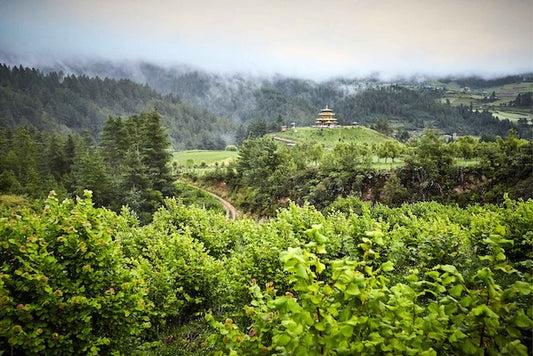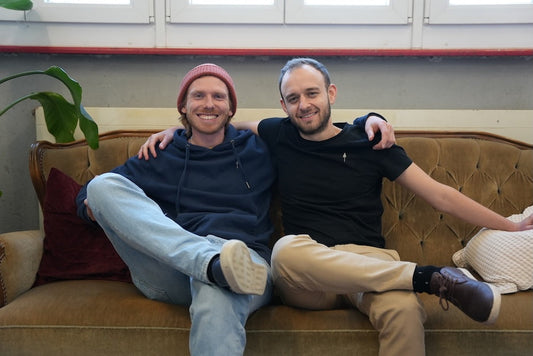This project is dedicated to the reforestation of wind-ravaged areas in the Eastern Carpathians, a mountainous region in Transylvania, Romania. The areas have been converted into spruce monocultures for agricultural reasons, but these are susceptible to extreme weather events due to their superficial roots. This area is therefore to be replaced by a natural mixture of spruce, beech and pine, which will promote biodiversity and make the trees more resistant. This will also enable increased absorption of CO2.
The project also has a social impact. The local community is actively involved in the planting and maintenance measures, which creates local jobs. In addition, this project enables pupils and students to receive practical training and further education in the field of forestry under the guidance of the local community.
//nikinclothing.com/cdn/shop/files/DJI_0154_f1e45cdf-2b6d-49d3-876e-52d334045727.jpg?v=1716559989
//nikinclothing.com/cdn/shop/files/DJI_0157_5823ad8c-f295-442e-bded-471533f5843d.jpg?v=1716559989
//nikinclothing.com/cdn/shop/files/IMG_9763_9eeddf2b-582c-410e-89ee-2e6beed8a744.jpg?v=1716560012
//nikinclothing.com/cdn/shop/files/IMG_9839_33d7614c-de78-49f9-ae74-fa7a613956c8.jpg?v=1716560012
Africa has the world's second largest tropical forest, the Congo Basin rainforest, and is home to 17 percent of the planet's forest cover. Unfortunately, Africa is threatened by deforestation at four times the global rate, which not only puts the livelihoods of local communities at risk, but also impacts the planet as a whole.
The African Forest Landscape Restoration Initiative (AFR) aims to restore 100 million hectares (AFR100) of deforested land in Africa by 2030. However, it's not just about reforestation. The project will also create jobs to reduce poverty in local communities. For example, fruit trees are planted, which helps feed impoverished families.
In addition, the aim is to join forces to improve resilience to climate change and mitigate climate change. Indeed, planting trees helps to minimize the impact of, for example, increasingly violent storms. During the month of December, NIKIN is funding one tree per product sold as part of AFR100. Our trees will move into their new habitat in the Burundi area.
//nikinclothing.com/cdn/shop/files/AFR100-1.jpg?v=1697186361
//nikinclothing.com/cdn/shop/files/AFR100-2.jpg?v=1697186361
//nikinclothing.com/cdn/shop/files/AFR100-3.jpg?v=1697186361
Shakti Reforestation Ltd. is working with Alberta-Pacific Forest Industries Inc. to replant the area burned by the McMillan Complex forest fire in 2019 with seedlings. The reforestation project complies with all applicable federal and provincial laws, particularly those related to public lands, water, forests and forestry, Indigenous consultation, and worker health and safety. A total of 500 trees of two tree species will be planted in this small exploratory project, which will serve as a test of Shakti's collaboration with APFI as well as a suitability test of the land to be planted.
//nikinclothing.com/cdn/shop/files/alberta-canada-1.jpg?v=1709218121
//nikinclothing.com/cdn/shop/files/alberta-canada-2.jpg?v=1709218120
//nikinclothing.com/cdn/shop/files/alberta-canada-3.jpg?v=1709218121
The Polylepis forests in South America are a vital part of the water and ecosystem of the Andes and the Amazon. The Acción Andina initiative aims to protect and reforest these forests. The area covers one million hectares of land in Argentina, Bolivia, Chile, Colombia, Ecuador, Peru and Venezuela.
The project is thus helping to combat climate change, improve land and food security and protect endangered animal species. The initiative also benefits the indigenous population. They are heavily dependent on the forests that form the basis of their livelihoods.
Another aim is to protect the forest at community and government level and to engage with parties that are driving forward the deforestation of the Polylepis forests.
//nikinclothing.com/cdn/shop/files/Andes_2020_21_-_4.jpg?v=1697445717
//nikinclothing.com/cdn/shop/files/Andes_2020_21_-_3.jpg?v=1697445717
//nikinclothing.com/cdn/shop/files/Andes_2020_21_-_1.jpg?v=1697445717
//nikinclothing.com/cdn/shop/files/Andes_2020_21_-_2.jpg?v=1697445717
Protecting and reforesting forest ecosystems in the Andes
Acción Andina is a project that focuses on the protection and restoration of high-altitude and inaccessible forest ecosystems in the Andes. This includes measures to protect native forests, reforestation projects and targeted capacity and leadership development to strengthen local conservation efforts. The project is divided into several smaller projects, each involving the identification of reforestation sites, collaboration with local communities, the establishment and management of tree nurseries, training and community tree planting activities.
Social and ecological focus of the project
The Acción Andina project works closely with local communities. Local social structures, cultural spaces and values as well as political organizations are respected and included in the planning of the sub-projects. The local communities, often including indigenous groups, are consulted at the planning stage to ensure that the project is sustainable and functional in the long term. This also creates jobs from which the local communities benefit directly.
Ecologically, attention is also paid to local conditions, with only native tree species being planted. When selecting sites, a special focus is placed on areas where Polylepis trees grow. Polylepis forests play a central role in preserving regional biodiversity as water sources and as catalysts for carbon-rich soils.
//nikinclothing.com/cdn/shop/files/Anden-1.jpg?v=1706541243
//nikinclothing.com/cdn/shop/files/Anden-2.jpg?v=1706541244
//nikinclothing.com/cdn/shop/files/Anden-3.jpg?v=1706541243
//nikinclothing.com/cdn/shop/files/Anden-4.jpg?v=1706541244
//nikinclothing.com/cdn/shop/files/Anden-5.jpg?v=1706541244
Reforestation in the Sierras Grandes de Córdoba - Argentina
This project reforests areas that were previously severely damaged by livestock farming and fires. The reforestation is intended to make the soil more resistant, restore habitats for flora and fauna and increase the amount of water in the surrounding rivers. The planted Polylepis trees are considered to be particularly fire-resistant and moisture-promoting, creating evergreen areas. This greening of stony and dry soils also binds CO2 and lowers the local temperature.
Five project groups
The project involves various project groups that work in stages. First, suitable areas are identified, around which a second group then builds cattle fences to protect the future seedlings and the general flora. Polylepis seeds are then collected and grown in the nursery before the next group plants them. The fifth group is responsible for the regular monitoring of the cattle fences and the scientific measurement of their impact.
Benefits for the community
The local communities are heavily involved in the reforestation process. The five working groups create jobs in different areas of expertise, enabling the involvement of community members with different interests and work experience. This project also promotes the economic attractiveness of the Pampa de Achala region.
//nikinclothing.com/cdn/shop/files/Argentina-OTP-1.jpg?v=1703217778
//nikinclothing.com/cdn/shop/files/Argentina-OTP-4.jpg?v=1703217778
//nikinclothing.com/cdn/shop/files/Argentina-OTP-3.jpg?v=1703217779
//nikinclothing.com/cdn/shop/files/Argentina-OTP-2.jpg?v=1703217779
As promised, we also plant a tree for each co-owner of NIKIN - in Denmark.
This project will establish multifunctional forests on marginal farmland in West Jutland, which will be permanently protected by the Danish Forest Act. The forests increase carbon uptake, protect groundwater and store nitrogen, which reduces eutrophication - the accumulation of nutrients - of wetlands in the area.
It also promotes biodiversity by creating a protected area for the endangered dormouse and habitat for birds and insects.
The local population benefits from numerous recreational opportunities offered by the forest area, as well as from the "School in the Forest" initiative, which is an important educational element.
//nikinclothing.com/cdn/shop/files/One-Tree-Planted_Woodland-0-6-years_-_3.jpg?v=1697448534
//nikinclothing.com/cdn/shop/files/One-Tree-Planted_Woodland-0-6-years_-_2.jpg?v=1697448534
This project in Australia focuses on helping with bushfires and the reforestation of burnt forests. The project is divided into many smaller initiatives spread across Australia.
In total, up to one million new trees are to be planted, both on private and public land. The livelihood of animals, the establishment of tree nurseries and general support for the affected communities are at the forefront of the project.
Particularly endangered species such as the koala and the brown-headed kakdu are already prioritized in the planning of new habitats. The communities are also to be empowered to carry out future reforestation on their own.
//nikinclothing.com/cdn/shop/files/Australia_2020-25-2.jpg?v=1697187716
This project in Australia focuses on helping with bushfires and the reforestation of burnt forests. The project is divided into many smaller initiatives spread across Australia.
In total, up to one million new trees are to be planted, both on private and public land. The livelihood of animals, the establishment of tree nurseries and general support for the affected communities are at the forefront of the project.
Particularly endangered species such as the koala and the brown-headed kakdu are already prioritized in the planning of new habitats. The communities are also to be empowered to carry out future reforestation on their own.
//nikinclothing.com/cdn/shop/files/Australia_2020-25-1.jpg?v=1697187716
//nikinclothing.com/cdn/shop/files/Australia_2020-25-2.jpg?v=1697187716
Our partner One Tree Planted is working with Project Platypus in Australia to re-vegetate the largely cleared landscape between the Grampians National Park and the Pyrenees. Due to extensive agriculture, these two areas are no longer connected by natural forests.
Connecting the two areas through newly planted trees will allow the natural flow of species and genetic material to return to western Victoria. The trees will be planted mainly by local volunteers and in cooperation with local landowners. The aim is to provide a healthy habitat for all species and to educate the community about why revegetation is so important for the sustainability of the agricultural landscape.
//nikinclothing.com/cdn/shop/files/Australia_2021_-_1.jpg?v=1697445579
//nikinclothing.com/cdn/shop/files/Australia_2021_-_2.jpg?v=1697445578
//nikinclothing.com/cdn/shop/files/Australia_2021_-_3.jpg?v=1697445578
In the southwest of Western Australia is one of the biggest hotspots for biodiversity. Nowhere else in the world have so many different plant species within one region as here. In addition, many of these species date back to prehistoric times, as there have been no glaciers in this region for 250 million years and thus the survival of the species is uninterrupted.
However, parts of the area have been cleared for large-scale agriculture in recent decades. Now, new seedlings are to be planted both mechanically and by hand. This is intended to reconnect the different vegetation areas, promote animal circulation in the area and also preserve biodiversity.
Both the local inhabitants and the indigenous people (called Noongar) are involved in the project. The initiative is part of a larger effort, which is also supported by the UN.
//nikinclothing.com/cdn/shop/files/Australia_2022_-_2.jpg?v=1697447169
//nikinclothing.com/cdn/shop/files/Australia_2022_-_1.jpg?v=1697447169
//nikinclothing.com/cdn/shop/files/Australia_2022_-_3.jpg?v=1697447169
//nikinclothing.com/cdn/shop/files/Australia_2022_-_4.jpg?v=1697447169
Mangroves are trees and shrubs that grow in saltwater ecosystems of tropical and subtropical coastal areas. They form an important ecological niche, acting as a transition between sea and land and providing habitat for many animals and plants. Mangrove forests play a critical role in protecting coastlines from erosion, tsunamis, and storms. They also serve as carbon sinks, storing large amounts of carbon in their biomass.
In the southwestern part of Bangladesh lies the largest mangrove forest in the world, the Sundarbans. Due to climate change, the mangrove ecosystems are highly endangered. To counteract this, we are actively implementing mangrove planting with our partner One Tree Planted, the organization BEDS and coastal communities. The project will protect coastal communities from natural disasters and increase mangrove coverage.
This means that we will plant mangroves in the coastal belt to strengthen the dike and create new livelihoods for coastal residents. The project follows the nine steps for Community-Based Ecological Mangrove Restoration (CBEMR) to create long-term benefits for local communities. Our tree planting project in May provides an opportunity to preserve the largest mangrove ecosystem in the world.
//nikinclothing.com/cdn/shop/files/Bangladesh_2023_-_4.jpg?v=1697447780
//nikinclothing.com/cdn/shop/files/Bangladesh_2023_-_3.jpg?v=1697447779
//nikinclothing.com/cdn/shop/files/Bangladesh_2023_-_1.jpg?v=1697447780
//nikinclothing.com/cdn/shop/files/Bangladesh_2023_-_2.jpg?v=1697447780
On May 1, 2023 we will release our first major shoe collection in collaboration with Ochsner Shoes. With the purchase of NIKIN shoes you support the tree planting project of My Forest Armenia. Due to the intensive grazing in the Lori region, north of the Bazum Mountains, the tree population has been extremely reduced in recent years. Now, on the one hand, non-forested areas are to be reforested and, on the other hand, weakly forested areas are to be supported in their natural regeneration processes.
The work is done manually, as the slope is too steep for machines. The goal is to create permanent forests with a high seedling survival rate. Through the project, we also create jobs for local people, which supports the local economy and raises awareness among local people.
//nikinclothing.com/cdn/shop/files/lukasz-szmigiel-jFCViYFYcus-unsplash_1_fefc73a1-a95b-42ef-abfc-8d6badfd30f3.jpg?v=1716560065
With our Forest Collection, we also support the Swiss forest: for every TreeShirt sold, we donate a tree worth 2.90 Swiss francs to the Rietenberg forestry operation. Unfortunately, many conifers on the Rietenberg (AG) have fallen victim to the bark beetle and died. In April 2024, the work will begin and the area will be replanted to rebuild the important forest ecosystem, which provides the basis of life for numerous animals and plants.
This project in Bhutan focuses on planting valuable fruit trees. More than 100,000 of them are to be planted mainly in the eastern and central regions of Bhutan. These parts of the country, with a population of about 771,000, are increasingly home to the poorer sections of the population. The focus of the project is to reforest these regions and make the land usable. This should increase the agricultural productivity of the land and relieve the pressure on existing forests. It can also promote clean drinking water and food security.
The following types of trees are planted: mango, avocado, apple, pear, peach, plum, cherry, hazelnut, walnut and chestnut trees. Each of the trees has a total of 7.5 metres by 7.5 metres to itself. In the end, there will be a total of 187 trees on one hectare of land.
//nikinclothing.com/cdn/shop/files/bhutan-1_1.jpg?v=1697187060
//nikinclothing.com/cdn/shop/files/bhutan-2_1.jpg?v=1697187059
//nikinclothing.com/cdn/shop/files/bhutan-3_1.jpg?v=1697187059
//nikinclothing.com/cdn/shop/files/bhutan-4_1.jpg?v=1697187060
Your tree was planted for a special project of BOS Switzerland. Since the foundation of BOS Switzerland in 2004, the association has been committed to the protection of the last Bornean orangutans and the preservation of their habitat. With your tree you support the One-Tree-One-Life-Campaign 2021, which enables the reforestation of the rainforests in Indonesia, which is important for the world climate.
With an annual deforestation of 1.3 million hectares of Indonesian rainforest, the region has one of the highest deforestation rates in the world. The project counteracts this high rate and secures important habitat for orangutans and other endangered species. BOS Switzerland runs the project together with volunteers and staff. The aim is also not "just" to reforest, but to protect existing forest areas in the long term.
//nikinclothing.com/cdn/shop/files/BOS_-1.jpg?v=1697187378
The project has special significance for NIKIN as Carla, part of the management team and with NIKIN since the beginning, is from Sete Lagoas. Our donation to the organization Terrenus, which manages the project, was crucial in enabling the creation of a new NGO that has driven the project forward and attracted further supporters.
The project aims to reforest the Cerrado biome, which has been severely affected by deforestation. Phase 1 begins in degraded areas of the Santa Helena APA in Sete Lagoas, Minas Gerais, with the planting of trees and their long-term maintenance. In phase 2, the reforestation will be extended to other locations in the Cerrado in order to achieve an even greater positive impact on the region.
Through our commitment, we not only support reforestation, but also help to create a basis for long-term nature conservation projects in Carla's home town.
By the way: Carla and Nicholas will be visiting the project themselves in December and will be able to share more pictures here from then on. For now, you can see the seedlings to be planted in the videos here.
//nikinclothing.com/cdn/shop/files/brasilien_24.jpg?v=1732810141
The project in Carla's home town of Sete Lagoas is entering the next round - bigger, more diverse and even more effective. After a successful start last year, more are now being planted - across several areas in and around the APA Serra de Santa Helena conservation area in the Cerrado.
A special highlight: in addition to the traditional planting of tree seedlings, the "Muvuca" method is now also being used - a mix of native seeds that revitalizes particularly steep or hard-to-reach areas.
The new areas named "Jacqueline", "Eliane" and "Rodrigo" were all provided voluntarily by local private individuals. Some of these areas were severely damaged by a major fire in the Cerrado. Reforestation is now all the more important - ecologically, socially and locally anchored.
What is particularly great is that over 250 volunteers from the region - including many families - are actively involved. This shows how much awareness of nature conservation has grown locally and how much hope there is in this project.
//nikinclothing.com/cdn/shop/files/nikin_treeplanting_project_brasilien_3.jpg?v=1764595073
//nikinclothing.com/cdn/shop/files/nikin_treeplanting_project_brasilien_2.jpg?v=1764595073
//nikinclothing.com/cdn/shop/files/nikin_treeplanting_project_brasilien_1.jpg?v=1764595073
The project has special significance for NIKIN as Carla, part of the management team and with NIKIN since the beginning, is from Sete Lagoas. Our donation to the organization Terrenus, which manages the project, was crucial in enabling the creation of a new NGO that has driven the project forward and attracted further supporters.
The project aims to reforest the Cerrado biome, which has been severely affected by deforestation. Phase 1 begins in degraded areas of the Santa Helena APA in Sete Lagoas, Minas Gerais, with the planting of trees and their long-term maintenance. In phase 2, the reforestation will be extended to other locations in the Cerrado in order to achieve an even greater positive impact on the region.
Through our commitment, we not only support reforestation, but also help to create a basis for long-term nature conservation projects in Carla's home town.
By the way: In December, Carla and Nicholas visited the project and helped to plant trees.
//nikinclothing.com/cdn/shop/files/brasilien_24.jpg?v=1732810141
The Araguaia Biodiversity Corridor starts at the source of the Araguaia River in Emas National Park and goes over 2600km to Belem in northern Brazil, where the river flows into the Atlantic Ocean. The project for the corridor has a clear goal: to plant as many indigenous trees as possible. Out of 10.4 million hectares of land, 2 million hectares are to be reforested and 2.4 trillion trees planted. The area includes two of the largest ecosystems in the world: the Amazon rainforest and the Cerrado savannas.
NIKIN's partner One Tree Planted is involved in the huge project, which incidentally supports the UN Sustainable Development Goals (https://sdgs.un.org/goals), with two tree nurseries. To guarantee a sustainable implementation, the project takes place in cooperation with private local landowners.
//nikinclothing.com/cdn/shop/files/Brazil_2021_-_1.jpg?v=1697446022
//nikinclothing.com/cdn/shop/files/Brazil_2021_-_3.jpg?v=1697446022
//nikinclothing.com/cdn/shop/files/Brazil_2021_-_2.jpg?v=1697446022
//nikinclothing.com/cdn/shop/files/Brazil_2021_-_4.jpg?v=1697446022
In 2017, large areas around the town of Williams Lake in western Canada in the province of British Columbia fell victim to the Hanceville wildfires. NIKIN's partner One Tree Planted is involved in both the Elephant Hill Fire Restoration and the Hanceville Fire Restoration. In total, over 100,000 trees have been planted.
The reforestation area is partly part of the indigenous people's land. The Yunesit'in First Nation (http://www.yunesitin.ca/) are therefore heavily involved in the project. Not only in the reforestation on site, but also in issues such as land management.
The project initiators also hope that the reforestation will counteract climate change and provide more habitat for wildlife in the region.
//nikinclothing.com/cdn/shop/files/British_Columbia_2020_-1.jpg?v=1697188784
//nikinclothing.com/cdn/shop/files/British_Columbia_2020_-2.jpg?v=1697188784
//nikinclothing.com/cdn/shop/files/British_Columbia_2020_-3.jpg?v=1697188784
The Hanceville forest fires of 2017 destroyed about 240,000 hectares of land. Part of this area will be able to regenerate itself. However, land on which Douglas fir forests stood before the fire will be additionally reforested.
//nikinclothing.com/cdn/shop/files/Hanceville-Fire-Restoration1_1.jpg?v=1697446457
//nikinclothing.com/cdn/shop/files/Hanceville-Fire-Restoration2_1.jpg?v=1697446456
//nikinclothing.com/cdn/shop/files/Hanceville-Fire-Restoration3_1.jpg?v=1697446457
This reforestation in British Columbia focuses on areas of old-growth forest that were destroyed by the Plateau Fire in 2017. These old-growth forests, known as OGMAs, are natural forests with no forestry. The 2017 Plateau Fire was the largest wildfire in British Columbia's history, burning 545,151 hectares of forest.
One Tree Planted, together with the regional Biodiversity Conservation Strategy Committee, has defined zones where the project will support the natural rehabilitation of the forest with afforestation. This is particularly important as the region's spruce and Douglas fir forests depend on living tree seeds for reproduction.
Without the additional aid, the natural regeneration of the forest would take up to 40 years. Both fauna and local indigenous community and farmers benefit from the project.
//nikinclothing.com/cdn/shop/files/British_Columbia_2021_-_1.jpg?v=1697445878
//nikinclothing.com/cdn/shop/files/British_Columbia_2021_-_3.jpg?v=1697445878
//nikinclothing.com/cdn/shop/files/British_Columbia_2021_-_2.jpg?v=1697445878
This reforestation in British Columbia focuses on areas of old-growth forest that were destroyed by the Plateau Fire in 2017. These old-growth forests, known as OGMAs, are natural forests with no forestry. The 2017 Plateau Fire was the largest wildfire in British Columbia's history, burning 545,151 hectares of forest.
One Tree Planted, together with the regional Biodiversity Conservation Strategy Committee, has defined zones where the project will support the natural rehabilitation of the forest with afforestation. This is particularly important as the region's spruce and Douglas fir forests depend on living tree seeds for reproduction.
Without the additional aid, the natural regeneration of the forest would take up to 40 years. Both fauna and local indigenous community and farmers benefit from the project.
//nikinclothing.com/cdn/shop/files/British_Columbia_2021_-_3.jpg?v=1697445878
//nikinclothing.com/cdn/shop/files/British_Columbia_2021_-_2.jpg?v=1697445878
//nikinclothing.com/cdn/shop/files/British_Columbia_2021_-_1.jpg?v=1697445878
This reforestation in British Columbia focuses on areas of old-growth forest that were destroyed by the Plateau Fire in 2017. These old-growth forests, known as OGMAs, are natural forests with no forestry. The 2017 Plateau Fire was the largest wildfire in British Columbia's history, burning 545,151 hectares of forest.
One Tree Planted, together with the regional Biodiversity Conservation Strategy Committee, has defined zones where the project will support the natural rehabilitation of the forest with afforestation. This is particularly important as the region's spruce and Douglas fir forests depend on living tree seeds for reproduction.
Without the additional aid, the natural regeneration of the forest would take up to 40 years. Both fauna and local indigenous community and farmers benefit from the project.
//nikinclothing.com/cdn/shop/files/British_Columbia_2021_-_3.jpg?v=1697445878
//nikinclothing.com/cdn/shop/files/British_Columbia_2021_-_2.jpg?v=1697445878
//nikinclothing.com/cdn/shop/files/British_Columbia_2021_-_1.jpg?v=1697445878
Yunesit'in is an aboriginal reserve in the Chilcotin Region of British Columbia in Canada. The area is repeatedly exposed to forest fires. This was also the case in 2017, when a large part of the forests, which also served as fire protection for the local inhabitants, was destroyed. Now, 107,480 aspen trees are to be planted to reforest the region. The new forest is also supposed to be more climate-resistant than its predecessor.
In addition to providing protection from forest fires, the trees will also enhance the reserve's biodiversity, improve habitat for resident wildlife and help recycle CO2. One Tree Plantet organises the project with the Yunesit'in government, the Cariboo Chilcotin Aboriginal Training Employment Centre (CCATEC), the BC Wildfire Service and the Ministry of Forests Lands and Natural Resource Operations. Mostly local volunteers are trained for the planting.
//nikinclothing.com/cdn/shop/files/treeplanting_image_nikin_1.jpg?v=1697446876
Discover our new tree planting project in British Columbia! After the devastating Plateau Fire of 2017, this month we will ensure that new seedlings thrive on the deforested areas.
The tree planting project in British Columbia aims to restore forest biodiversity that was severely impacted by the 2017 wildfire by planting annual seedlings.
The plantings are supported by local communities and, thanks to newly created habitats, are of great importance for both wildlife and the local economy.
The tree plantations create jobs for the local people, and the project provides a sustainable and long-term income, as it requires regular monitoring and maintenance work in the coming years. In addition, the local population is motivated to take care of nature and sensitized to the issue of environmental protection.
Our tree planting partner, One Tree Planted, has produced a documentary that takes a closer look at reforestation in British Columbia, "Keep Cool: Fortifying British Columbia." You can find the trailer here: Keep Cool: Fortifying British Columbia - Official Trailer | One Tree Planted
//nikinclothing.com/cdn/shop/files/British_Columbia_2023_-_1.jpg?v=1697447668
//nikinclothing.com/cdn/shop/files/British_Columbia_2023_-_2.jpg?v=1697447668
//nikinclothing.com/cdn/shop/files/British_Columbia_2023_-_3.jpg?v=1697447668
//nikinclothing.com/cdn/shop/files/British_Columbia_2023_-_5.jpg?v=1697447667
//nikinclothing.com/cdn/shop/files/British_Columbia_2023_-_4.jpg?v=1697447668
The province of British Columbia, Canada, was ravaged by devastating wildfires during the summers of 2017, 2018 and 2021. The fires devastated over 1.3 million hectares of land and completely killed the forests. The habitats and food sources of local wildlife were severely impacted and indigenous communities lost their traditional hunting grounds and food sources, threatening their way of life. In collaboration with planting partner Zanzibar, we are reforesting an area of 5 hectares with different tree species so that local communities can rebuild their livelihoods and future.
//nikinclothing.com/cdn/shop/files/cariboo-canada-1.jpg?v=1709218385
Choco in Colombia has one of the most biodiverse ecosystems in the world. Over 8000 plant species and 600 bird species can be found in the region. In the 2000s, 60% of the forests were lost due to deforestation and mining activities.
The project in Colombia aims to reforest 100 hectares of land, create new habitats for animals and improve water, land and air quality. The forests are expected to filter 15,000 tons of CO2 from the atmosphere in the future.
In addition to local trees, fruit trees and medicinal plants will also be planted. The poor sections of the population are to benefit directly from these. 50 women are being trained as independent entrepreneurs to sell the fruit and plants on the local markets.
//nikinclothing.com/cdn/shop/files/colombia-1.jpg?v=1697189037
//nikinclothing.com/cdn/shop/files/colombia-2.jpg?v=1697189037
//nikinclothing.com/cdn/shop/files/colombia-3.jpg?v=1697189037
In April 2023, NIKIN is supporting the Colorado project with 9,000 trees to advance the regeneration of the Rio Grande National Forest.
In the mid-2000s, the Rio Grande National Forest was attacked by the spruce bark beetle, which killed more than 98 percent of the forest's Engelmann spruce. Fueled by prolonged droughts, the effects on the ecosystem were catastrophic and many wildlife species, such as the Canada lynx, lost their habitat.
In addition, in 2013, an area of approximately 79,615 acres in the Rio Grande National Forest was the victim of a wildfire. This was the largest fire in the history of the high elevation Spruce Fir forests in Colorado.
To accelerate regeneration, a total of 55,500 trees will be planted in Mineral County of the Rocky Mountain in 2023, 9,000 of which will be funded by NIKIN.
This is to protect the area from flooding and bring back habitats for wildlife and plants.
//nikinclothing.com/cdn/shop/files/Colorado_2023_-_1.jpg?v=1697447460
//nikinclothing.com/cdn/shop/files/Colorado_2023_-_2.jpg?v=1697447459
//nikinclothing.com/cdn/shop/files/Colorado_2023_-_3.jpg?v=1697447460
//nikinclothing.com/cdn/shop/files/Colorado_2023_-_4.jpg?v=1697447459
In this project, multifunctional forests are being established on marginal farmland on the West Jutland peninsula. The new forest areas are permanently protected by the Danish Forest Act. The new forests are intended to increase carbon uptake in the area and protect the groundwater. The afforestation can also retain nitrogen to reduce the nutrient enrichment of the wetlands in the region.
By creating a protected area for the endangered dormouse, species protection is ensured. next The reforestation provides more habitat for many bird and insect species.
Local residents will benefit from the project through the many recreational opportunities and the "School in the Forest" initiative, which will be a key educational element.
//nikinclothing.com/cdn/shop/files/Denmark_2021_-_2.jpg?v=1697190990
//nikinclothing.com/cdn/shop/files/Denmark_2021_-_1.jpg?v=1697190991
The goal of this project is to revitalize deforested land in the Dominican Republic where, with our partner One Tree Planted, we aim to help plant and care for 1,275,000 trees.
Within the framework of the holistic "Plant With Purpose" approach, the restoration of the forest also aims to achieve sociological improvements. For example, many local farmers are to be involved in the project in order to raise awareness for the environment. As poverty decreases, competition for resources (such as land and fuel) diminishes, and communities come together in peace and reconciliation to improve and preserve the environment in their watersheds.
Reforestation through agroforestry is critical to restoring ecosystems, improving livelihoods, and promoting environmental stewardship. In the Dominican Republic, three different types of plots are used for reforestation: Forestry, Agroforestry for shade coffee, and Agroforestry for multi-story cacao. Farmers* choose which concept to apply on their land depending on the ecosystem and market demand. The seedlings are raised in nurseries located on the farmers' plots.
The local team has developed a three-pillar approach to restoration that leads to ecological regeneration, economic empowerment and spiritual renewal. This enables farmers to live and work in a way that protects their land as a byproduct of their values, rather than being imposed from above.
The key is that caring for the environment and the well-being of the community becomes an integral value for Plant With Purpose participants and their networks. For example, the program teaches the following tree care and maintenance techniques: tree seed collection and treatment, nursery establishment and management, tree planting techniques, grafting, pruning, and more. Tree species and locations are selected by community members and small farmers based on their needs and preferences. As a result, the farmers are highly motivated to think long-term and care for the trees over time.
//nikinclothing.com/cdn/shop/files/Dominican_Republic_2022-1.jpg?v=1697186467
//nikinclothing.com/cdn/shop/files/Dominican_Republic_2022-2.jpg?v=1697186467
//nikinclothing.com/cdn/shop/files/Dominican_Republic_2022-3.jpg?v=1697186467
//nikinclothing.com/cdn/shop/files/Dominican_Republic_2022-4.jpg?v=1697186467
Networking of the forests around Brussels
As part of our collaboration with the Aarau brewery "Stadtwächter", we plant a tree for every 6-pack of "Forest Ales" sold. Together with local volunteers and One Tree Planted, we are supporting a reforestation project in Brussels' Green Belt. The project removes barriers to community participation in reforestation, provides expert support and encourages active citizen participation in environmental goals.
Ecological benefits
The project aims to create natural bridges between existing forests that serve to promote species exchange between nature reserves. It also enhances existing forests by introducing new species. Targeted reforestation supports natural regeneration, creating sustainable forests. In the choice of tree species planted, the focus is on climate-resistant species that contribute to biodiversity and forest quality.
//nikinclothing.com/cdn/shop/files/Brussel-4.jpg?v=1698130424
//nikinclothing.com/cdn/shop/files/Brussel-3.jpg?v=1698130424
//nikinclothing.com/cdn/shop/files/Brussel-1.jpg?v=1698130424
//nikinclothing.com/cdn/shop/files/Brussel-2.jpg?v=1698130424
This project is the first large-scale climate forest ever to be planted in Germany. It is to be created around 40 kilometers from Cologne in North Rhine-Westphalia. Over 20 different tree species that are particularly climate-resistant are to be planted for the Life Terra climate forest. The trees will come from Spain and local German nurseries.
Each individual tree will be located and marked on a map. Visitors will be able to view detailed information as well as the financial backers. A tour is also to be created for interested parties.
The project is being realized in collaboration with Life Terra (https://lifeterra.eu/de/about-the-project/). Two tree planting events with the local population are planned for 2021.
//nikinclothing.com/cdn/shop/files/Germany_2020_21_-1.jpg?v=1697191274
//nikinclothing.com/cdn/shop/files/Germany_2020_21_-2.jpg?v=1697191274
The project in the Ostattika region near Athens aims to combat the effects of severe forest fires since 2018. The loss of wild ecosystems is to be compensated for by planting native tree species and shrubs. The project covers several locations and includes 40,000 trees, including cypresses, carob trees, laurels and Judas trees. The ecological benefit lies in the creation of habitats for animals such as foxes, rabbits and eagles as well as the absorption of around 880,000 kg of CO2. In addition, animals that had to retreat to inhabited areas due to the loss of their habitats can once again live in their natural habitat. The community also benefits from this project: the re-vegetation improves the air quality and increases the aesthetic value of the region.
//nikinclothing.com/cdn/shop/files/Nikin_OTP_Greece_2024_1.jpg?v=1716560353
//nikinclothing.com/cdn/shop/files/Nikin_OTP_Greece_2024_2.jpg?v=1716560354
//nikinclothing.com/cdn/shop/files/Nikin_OTP_Greece_2024_3.jpg?v=1716560354
The mangrove forests along the Pacific coast of Guatemala are of crucial importance for the stability of the region and the livelihoods of the coastal inhabitants. Unfortunately, these ecosystems are threatened by illegal logging, waste pollution and dams. These activities disrupt bird habitats, increase coastal erosion and make the region more vulnerable to extreme weather events. To address these challenges, the project plans to restore the mangrove ecosystem by planting and monitoring mangrove and deciduous trees on local farms and in watersheds.
//nikinclothing.com/cdn/shop/files/Nikin_OTP_Guatemala_2024_1.jpg?v=1717137653
//nikinclothing.com/cdn/shop/files/Nikin_OTP_Guatemala_2024_2.jpg?v=1717137653
//nikinclothing.com/cdn/shop/files/Nikin_OTP_Guatemala_2024_3.jpg?v=1717137653
The mangrove forests along the Pacific coast of Guatemala are of crucial importance for the stability of the region and the livelihoods of the coastal inhabitants. Unfortunately, these ecosystems are threatened by illegal logging, waste pollution and dams. These activities disrupt bird habitats, increase coastal erosion and make the region more vulnerable to extreme weather events. To address these challenges, the project plans to restore the mangrove ecosystem by planting and monitoring mangrove and deciduous trees on local farms and in watersheds.
//nikinclothing.com/cdn/shop/files/Nikin_OTP_Guatemala_2024_1.jpg?v=1717137653
//nikinclothing.com/cdn/shop/files/Nikin_OTP_Guatemala_2024_2.jpg?v=1717137653
//nikinclothing.com/cdn/shop/files/Nikin_OTP_Guatemala_2024_3.jpg?v=1717137653
In the mountainous regions of Bhutan, the planting of hazelnut trees on fallow and degraded slopes is creating new prospects for smallholder families. Together with OneTreePlanted and its local partner, we are promoting long-term income opportunities and the ecological regeneration of the Himalayan region. The trees stabilize the soil, bind CO₂ and provide local communities with a reliable source of income for decades. In addition, the farmers receive training, support in caring for the trees and a guaranteed purchase of the harvest. This creates a cycle of economic strengthening, social progress and ecological impact that will also reach future generations.
//nikinclothing.com/cdn/shop/files/Bhutan_5.jpg?v=1761751138
//nikinclothing.com/cdn/shop/files/Bhutan_4.jpg?v=1761751138
//nikinclothing.com/cdn/shop/files/Bhutan_1.jpg?v=1761751138
//nikinclothing.com/cdn/shop/files/Bhutan_3.jpg?v=1761751138
//nikinclothing.com/cdn/shop/files/Bhutan_2.jpg?v=1761751138
In April, all trees that are not included in the sale of a shirt from the Forest Collection (special capsule) go to Mauna Kea Restoration. The trees will be planted in the Hāmākua Restoration Area, the Ka`ohe Restoration Area, the Pu`u Mali Restoration Area and the Mauna Kea Forest Reserve. The aim is to restore forests and strengthen existing forests to counteract forest fires and non-indigenous weeds. The Mauna Kea Restoration project protects native flora and fauna. The project is an important part of a larger restoration that is planned for a period of over a decade.
//nikinclothing.com/cdn/shop/files/Hawai-project-2_d16d1bf6-321d-49f1-a496-b88ab5f76b4d.jpg?v=1714460707
Restoring ecological diversity
Honduras suffers from one of the highest rates of deforestation in the world, which has significant impacts such as water scarcity, soil loss and flooding. To address this challenge, we are working with One Tree Planted to plant seedlings on 4,000 hectares of land. This reforestation is intended not only to restore ecological diversity in the affected regions, but also to strengthen the local economy. This is supported by planting high-quality wood species and agricultural goods such as coffee or cocoa.
Learning together with the community
Together with One Tree Planted, we not only want to help nature, but also strengthen the community. This includes involving the local population in the project and indirectly promoting regional food security. In addition, environmental education initiatives are to be implemented, particularly for children and young people. After all, raising awareness among all generations is key to sustainably improving and protecting the ecological environment.
//nikinclothing.com/cdn/shop/files/Nikin_OTP_Honduras_1.jpg?v=1716559917
//nikinclothing.com/cdn/shop/files/Nikin_OTP_Honduras_3.jpg?v=1716559917
//nikinclothing.com/cdn/shop/files/Nikin_OTP_Honduras_2.jpg?v=1716559918
The "Dragon's Nest" is a farm estate with 170 hectares of former farmland, which is now to be reforested. The main objectives are carbon sequestration, also known as carbon capture, and soil conservation.
The reforestation is to consist of various tree species and promote biodiversity. The forest will be home to fungi, soil organisms, birds and other animal species. The planned vegetation can also distribute fresh water better and therefore also benefits insects, crustaceans and fish. Gaps will be left in the reforestation to allow ground plants enough light.
In the longer term, there is the possibility of establishing timber production. Other jobs, such as planting the trees, will be given to local workers. The local population from the village of Breiðdalsvík can enter the area freely.
//nikinclothing.com/cdn/shop/files/Iceland_2021.jpg?v=1697201551
In this tree planting project, 60,000 trees are planted near the village of Skagaströnd in Iceland. The area on Seer Hill of around 115 hectares of land was previously cleared. Already, Alaskan lupines (which are native legumes) have established themselves on the area. This definitely has ecological advantages for the soil, but this plant species can also spread too much.
Now the trees are to increase the biodiversity of the region and protect against soil erosion. In the future, the mature trees will also provide protection for the village from snow gusts. When choosing the trees, the project management restricted itself to native trees that can withstand the seasons well. Once they are fully grown and offer sufficient protection, other weather-sensitive tree species can be added.
//nikinclothing.com/cdn/shop/files/planted.jpg?v=1697447054
//nikinclothing.com/cdn/shop/files/lupinefield.jpg?v=1697447055
//nikinclothing.com/cdn/shop/files/FortunetellerHillfromtown.jpg?v=1697447054
In this project, 900,000 fruit trees have been planted in India since 2020. More specifically, in the regions of Uttar Pradesh, Haryana, Odisha, Uttarakhand, Maharashtra and West Bengal. In addition, 100,000 mangrove seedlings are being planted in the Sundarbans.
The aim is to support local smallholders and provide them with a secure livelihood. Within three years of the start of the project, a tree will generate an average of 10 dollars more per year for a family. While this may not sound like much by Western standards, this additional income means a lot for families in India.
While the small farmers thus have more food security and income, the fruit trees also absorb up to 2500 tons of CO2 from the air, conserve water and protect against soil erosion.
//nikinclothing.com/cdn/shop/files/India_2020_-3.jpg?v=1697188873
//nikinclothing.com/cdn/shop/files/India_2020_-2.jpg?v=1697188873
//nikinclothing.com/cdn/shop/files/India_2020_-1.jpg?v=1697188874
One Tree Planted has been planting fruit trees in India with local partners for 5 years. More than 1.5 million trees have already been planted, contributing to an additional income for marginalised farmers and facilitating access to food in inhospitable areas. True to the motto "Fruit trees change lives".
In 2021, two more nurseries will be added and another 1.5 million fruit trees will be planted. The tree nurseries will be built in the local communities and create new jobs there. For the new jobs, marginalised groups of people such as widows and older women will be given priority. In this way, the UN Sustainable Development Goals such as gender equality can be promoted and achieved.
//nikinclothing.com/cdn/shop/files/India_2021_3.jpg?v=1697446286
//nikinclothing.com/cdn/shop/files/India_2021_2.jpg?v=1697446286
//nikinclothing.com/cdn/shop/files/India_2021_1.jpg?v=1697446285
Our current tree planting project supports marginalized Indian communities in the states of Haryana, Uttar Pradesh, Uttarakhand, Rajasthan, Maharashtra, Odisha and West Bengal that are facing acute famine. Under this project, around 2.5 million fruit trees will be planted for smallholder farmers, which will help create sustainable livelihoods and provide nutritious food to local families and communities. It will also improve incomes while combating pollution, conserving water and minimizing soil erosion.
Our tree planting partner One Tree Planted and their local partners have already planted over 3.5 million fruit trees across India since 2017. In addition, local nurseries have been established with One Tree Planted's help since 2021. Local nurseries have the advantage of reducing the transportation of seedlings and improving the quality of seedlings as they are adapted to local conditions. These nurseries employ local labor, which brings additional social benefits to the communities. This is because in three years after planting, each fruit tree will contribute to additional income and nutrition of an average of US$10 per tree per year, leading to a significant reduction in hunger, malnutrition and poverty in the villages and communities where these trees are planted.
//nikinclothing.com/cdn/shop/files/India_2022-5.jpg?v=1697186869
//nikinclothing.com/cdn/shop/files/India_2022-1.jpg?v=1697186868
//nikinclothing.com/cdn/shop/files/India_2022-2.jpg?v=1697186868
//nikinclothing.com/cdn/shop/files/India_2022-3.jpg?v=1697186868
//nikinclothing.com/cdn/shop/files/India_2022-4.jpg?v=1697186868
In five zones spread over 3 provinces, trees are planted in this project in Indonesia. The provinces are West Java, Banten and Lampung. The initiative is intended to counteract the damage caused by deforestation and unsustainable agriculture. The reason for the deforestation is the increased global coffee consumption, which also leads to more coffee plantations in a large coffee producer like Indonesia.
In cooperation with Rainforest Alliance, environmentally conscious agriculture is to be established. At the heart of this are trees that provide sufficient shade and thus promote biodiversity. next the trees enable the coffee plant to thrive better. The farmers also benefit from this, as their yields increase and their income is boosted. A total of 500,000 tree seedlings are planted.
//nikinclothing.com/cdn/shop/files/Lampung_4.jpg?v=1697446945
//nikinclothing.com/cdn/shop/files/Lampung_5.jpg?v=1697446945
//nikinclothing.com/cdn/shop/files/Lampung_6.jpg?v=1697446945
This initiative is about both reforestation and sustainable forestry. The latter aims to show local farmers that more income can be generated through sustainable care of the trees and the land. This creates not only an ecological added value but also a financial one for the population.
For the reforestation, the organisers of the project plan to use different tree and plant species to grow a forest that is as natural and self-protecting as possible. 20,000 seedlings are to be planted, 73% of which are normal trees and 28% fruit trees. The fruit trees will benefit the local fauna, as they often find too little food during the hot season.
Afforestation is also intended to enhance the land, maintain water quality, reduce natural disasters (forest fires, floods) and promote biodiversity.
//nikinclothing.com/cdn/shop/files/Area-to-be-Reforested_1_5e769310-3cca-4934-8411-1f98d162a2ea.jpg?v=1716561689
//nikinclothing.com/cdn/shop/files/Insitu-Water-Pipes_1_0293330f-5933-4b2f-9041-55f01ecbaa85.jpg?v=1716561689
//nikinclothing.com/cdn/shop/files/Nursery-9_1_4cab12e4-e6cd-4890-83b1-bcc62f0849b2.jpg?v=1716561689
//nikinclothing.com/cdn/shop/files/nursery-1_1_61973ad0-b10e-4acb-a722-046b29107d3c.jpg?v=1716561689
Ireland has the lowest forest cover of all European countries, with a forest cover of only 11%. As part of the Ireland 2023 - Nationwide Community Tree Cover project, the aim is to increase the forest cover and plant 200,000 trees in the Republic of Ireland and Northern Ireland. This will involve planting native tree species from certified Irish seed, creating diverse habitats and also supporting biodiversity.
Particular focus is placed on involving local communities in the process of tree planting and care. This is intended to create more understanding and knowledge around the issue. The tree planting project also offers ecological benefits such as soil protection, water quality improvement, flood protection and air purification.
//nikinclothing.com/cdn/shop/files/Ireland_2023_-_3.jpg?v=1697447998
//nikinclothing.com/cdn/shop/files/Ireland_2023_-_2.jpg?v=1697447998
//nikinclothing.com/cdn/shop/files/Ireland_2023_-_1.jpg?v=1697447999
In the Likoni estuary in Kwale, Kenya, our partner Veritree is working with EarthLungs to restore valuable mangrove forests. These unique ecosystems not only protect the coastline from erosion, but also provide vital habitats for numerous organisms. Through reforestation, we are helping the local community to break free from the cycle of poverty and create new sources of income such as sustainable fishing and timber use. Your support helps to strengthen these coastal communities and preserve biodiversity.
//nikinclothing.com/cdn/shop/files/treeplanter_project_kenia-1.jpg?v=1727698936
//nikinclothing.com/cdn/shop/files/treeplanter_project_kenia-2.jpg?v=1727698935
The coast of Kenya is one of the least developed regions in the country, making it dependent on mangrove ecosystems for jobs, livelihoods and food. In recent decades, coastal areas in southern Kenya have been urbanized at an unprecedented rate. The mangrove forests have been cleared and exploited for other uses. This project restores the mangrove forests in Kenya to empower the coastal community to break the cycle of poverty. The restored mangrove forests will also help stabilize coastlines and act as a natural barrier against tropical storms.
//nikinclothing.com/cdn/shop/files/kwale-kenya-1.jpg?v=1709218416
//nikinclothing.com/cdn/shop/files/kwale-kenya-2.jpg?v=1709218416
//nikinclothing.com/cdn/shop/files/kwale-kenya-3.jpg?v=1709218417












